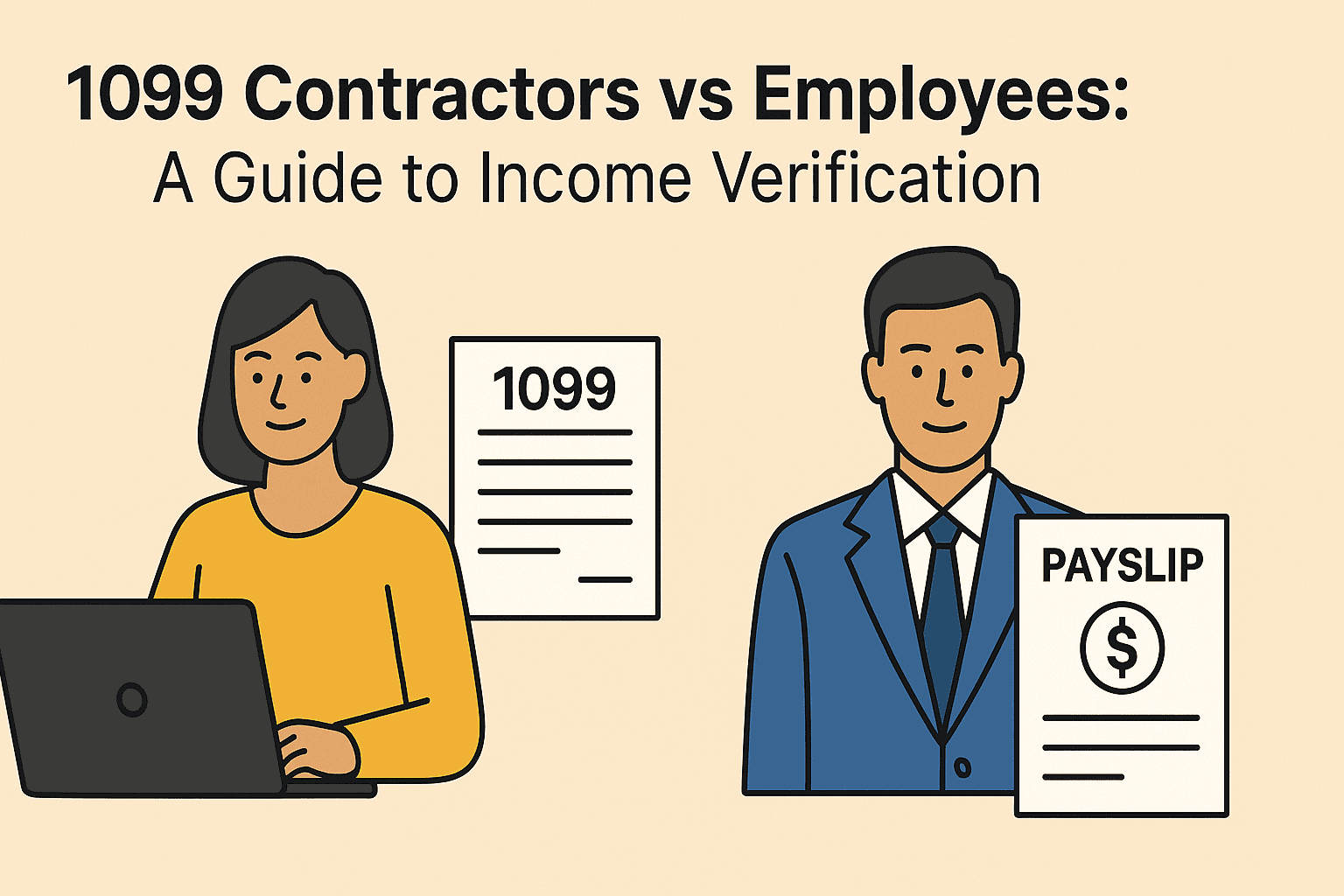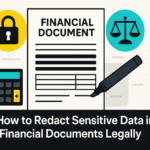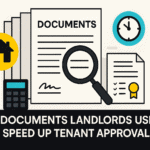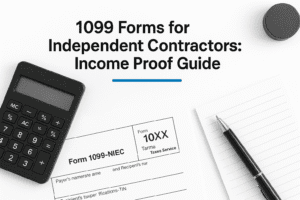Introduction: 1099 Contractors vs Employees — A Guide to Income Verification
By FinancialDocsProvider.com Editorial Team • Published: August 2025
Last updated: August 2025
If you’re applying for a rental, auto loan, mortgage, or small‑business financing, reviewers need to verify your income. The 1099 contractors vs employees distinction drives what documents you must provide, how they’re reviewed, and the risk checks applied. This guide explains what reviewers look for across the US, UK, and Canada — plus what’s legal to edit (formatting and redaction) and what’s strictly prohibited (changing facts).
We’re a compliance‑first editorial team. We help clients with proof of income editing and bank statement formatting so legitimate records are easier to read and verify. We do not fabricate numbers, dates, parties, or transactions.
Who this guide is for
- W‑2 employees who need a clean, consistent income packet for a landlord or lender.
- 1099/NEC contractors, freelancers, and gig workers who don’t receive pay stubs but still need dependable proof of income.
- UK workers navigating employment status (employee vs self‑employed; umbrella vs limited company) and IR35 questions.
- Canadian applicants assembling T4/T4A records, Notices of Assessment (NOA), and business activity statements.
Related Entities & Terms
- W‑2 (US employee wage statement)
- 1099‑NEC / 1099‑K / 1099‑MISC (US contractor statements)
- Payslips & P60 (UK employee documents)
- SA302 & Tax Year Overview (UK self‑assessment summaries)
- T4 & T4A (Canada employee/contractor slips)
- NOA (Canada Notice of Assessment), T2125 (Statement of Business Activities)
- IRS, CFPB (US); GOV.UK & FCA (UK); CRA & FCAC (Canada)
- IR35 / off‑payroll working (UK)
- Income verification letter / employment verification letter
- Bank statements, invoices, receipts, profit & loss (P&L)
For a step‑by‑step on drafting confirmation letters, see our guide on how to write an income verification letter. If a statement line looks wrong, review how to fix a bank statement error legally.

Law & Policy Basics: Formatting vs Falsification (US, UK & Canada)
“Employee” and “independent contractor” are legal concepts, not just job titles. They determine what proof exists and how it’s verified. Reviewers usually cross‑check your packet against bank activity, tax summaries, and employer/contractor records. Below are high‑level reference points; always confirm your personal situation on official sites.
United States: IRS worker classification
The IRS evaluates control, financial arrangement, and the relationship of the parties when distinguishing employees from contractors. Employees typically show W‑2s and pay stubs; contractors show 1099‑NEC/1099‑K plus invoices and business records. See the IRS overview: Independent Contractor (Self‑Employed) or Employee?
United Kingdom: Employment status & IR35
UK status hinges on control, substitution, and mutuality of obligation. Off‑payroll (IR35) rules may apply to certain engagements. Employees rely on payslips and P60s; self‑employed workers lean on Self Assessment documents (SA302 and Tax Year Overview) and invoices. Start here: GOV.UK: Employment status.
Canada: CRA employment status
The CRA considers factors like control, ownership of tools, chance of profit/risk of loss, and integration. Employees reference T4s and pay stubs; contractors may receive T4As and rely on business records, T2125, and the CRA’s Notice of Assessment. See: CRA: Employee or self‑employed?
How reviewers actually think
- Consistency: Numbers in pay stubs, tax forms, and bank deposits should align.
- Continuity: Steady employment or business activity over time reduces perceived risk.
- Traceability: Deposits should match known sources (employer names, platforms, client invoices).
- Legibility: Clean, searchable PDFs accelerate underwriting and cut follow‑up requests.
Allowed edits (formatting)
- Redacting partial account numbers or sensitive IDs.
- Combining statements into one PDF; adding bookmarks.
- OCR/searchability fixes; page orientation; resolution cleanup.
- Highlighting relevant lines without obscuring source data.
Illegal alterations (falsification)
- Changing amounts, dates, hours, pay rates, or tax withholdings.
- Editing employer/client names or EINs/UTRs/BNs.
- Adding deposits that never occurred; altering running balances.
- Manufacturing tax forms to misrepresent income.
We edit for clarity; we never fabricate or alter facts. If a figure is wrong, dispute it with the issuer or follow corrective procedures.
What Edits Are Allowed: Examples that Improve Readability
Formatting is lawful when it doesn’t change facts. Many applicants lose time because reviewers can’t quickly find what they need. Here are ways we help — all within compliance boundaries.
Lawful formatting that accelerates review
- Combine multi‑page statements into a single, bookmarked PDF so reviewers can jump to “Deposits,” “YTD totals,” or “Tax summaries.”
- OCR and text layer fixes so amounts are searchable and copyable; this reduces manual retyping errors.
- Consistent naming (e.g., “2024‑10 Payroll – ACME Corp – John Smith.pdf”) across your packet.
- Redaction of non‑essential data (partial account numbers, QR codes, routing numbers) while keeping transaction details intact.
- Legible exports when a portal only downloads ultra‑low‑resolution images; we re‑export for clarity without changing content.
Helpful internal guides
Explore our deeper articles on reviewer workflows and lawful corrections: how landlords and loan officers detect fake pay stubs and correcting a bank statement error legally. If you’re juggling different pay schedules, see biweekly vs semimonthly pay.
What’s Illegal: Alterations that Create Risk
Under fraud and forgery laws, it’s illegal to alter facts on pay stubs, tax forms, or bank statements. That includes adding or deleting transactions, changing amounts or dates, or substituting employer or client identities. Lenders and landlords cross‑check with third‑party databases, employer calls, and tax transcripts—misrepresentation is nearly always detected.
Potential consequences
- Application denial and internal blacklisting by lenders or property managers.
- Regulatory reporting and possible civil or criminal investigation.
- Damaged credit standing and strained future approvals.
If a document has a factual mistake, the compliant approach is to fix it at the source (HR/payroll, bank, tax agency) or provide a written explanation—never to alter the numbers. See our overview of Financial Documents FAQs for what we can and can’t do.
Use Cases & Mini‑Scenarios: What to Submit
Below are practical “document packets.” Pick the one that matches your situation and market. Then package it cleanly and consistently.
US — W‑2 Employees
- Last 2–4 pay stubs showing employer name, pay period, gross/net, and YTD totals.
- Most recent W‑2 (prior year).
- Last 2–3 months of bank statements showing payroll deposits.
- If applicable: a short income verification letter (HR or employer‑signed).
Mini‑scenario: You started six weeks ago and have only one pay stub. Provide your offer letter, first pay stub, and employer letter confirming start date and base pay. Add bank activity once the first deposit lands.
US — 1099 Contractors & Gig Workers
- 1099‑NEC and/or 1099‑K (latest tax year) from platforms or clients.
- 12 months of bank statements highlighting business deposits.
- Invoices or statements of work for top clients; simple P&L if available.
- Prior‑year tax return or Schedule C summary page.
Mini‑scenario: A rideshare driver with variable weekly earnings assembles 12 months of statements showing consistent deposits from the platform plus the 1099‑K. A one‑page monthly revenue summary helps underwriters assess stability.
UK — Employees
- Last 3 payslips and latest P60.
- 3–6 months of bank statements matching net pay.
- Employment letter when requested.
Mini‑scenario: You changed employers two months ago. Provide new payslips and an employer letter; include the prior P60 for historical context.
UK — Self‑Employed / Contractors
- SA302 Tax Calculation and Tax Year Overview (latest year).
- 6–12 months of bank statements showing business receipts.
- Invoices/contracts for key clients; umbrella payslips if applicable.
Mini‑scenario: You work via an umbrella company. Provide umbrella payslips and bank deposits; if taxed at source, add a brief note explaining the arrangement.
Canada — Employees
- Recent pay stubs and latest T4.
- 3 months of bank statements reflecting payroll deposits.
- Employer letter on request.
Canada — Self‑Employed / Contractors
- Latest NOA and T2125 (if you file it) or accountant letter.
- 6–12 months of bank statements; invoices for top clients.
- T4A slips if issued by payers.
Mini‑scenario: A freelance designer has two large clients. Provide invoices and contract excerpts showing rate and term; add bank deposits and the NOA for the tax year.
Context by application type
- Rentals: Landlords often prefer recent pay stubs (W‑2) or a long runway of deposits (1099). Some ask for 2.5–3× rent in gross or net income.
- Auto loans: Expect verification of recurring income and debt‑to‑income (DTI). Contractors should summarize monthly averages.
- Small‑business financing/SBA: Prepare tax forms plus business statements; separate personal vs business accounts in your packet.
- Mortgages: Underwriting is stricter. Contractors may need two years of returns or a documented exception; employees provide W‑2s and stable pay records.
For a deeper look at how screeners validate income artifacts, see how landlords and lenders spot fake pay stubs.
How We Work: Intake → Reconciliation → Formatting → Delivery
We help you package legitimate records so they’re easy to review. We do not change facts. Here’s our process:
1) Intake
- Describe your use case and reviewer requirements (e.g., “3 months of statements,” “last 2 pay stubs”).
- Share originals via a secure channel. If you’re missing something, we’ll explain compliant alternatives (e.g., employer letter, portal re‑download).
2) Reconciliation
- We check that deposits align with pay stubs or invoices.
- We flag obvious inconsistencies (e.g., negative balances vs claimed deposits) for you to resolve with the issuer.
3) Formatting
- Merge pages, apply bookmarks, and add a searchable text layer.
- Standardize naming conventions and page orientation; add optional highlights for key lines.
4) Delivery
- Receive a clean, organized PDF packet that reflects your originals.
- Turnaround is prompt for straightforward formatting; complex packets take longer. We’ll set expectations when you share your materials.
Learn more about our process and browse our services & pricing. When you’re ready, contact our team.
Compliance Checklist & Document Packaging Tips
Quick compliance check (save this)
- ☑ Facts only: no edits to amounts, dates, employer names, client names, or balances.
- ☑ Source‑traceable: deposits on statements match pay stubs, invoices, or platform payouts.
- ☑ Time‑window complete: provide the full period requested (e.g., entire last 3 months, not selected days).
- ☑ Identifiers intact: keep reference numbers and pay period dates visible.
- ☑ Redaction limits: hide only sensitive details (partial account numbers) — never transaction facts.
Packaging tips that speed up approvals
- Single PDF packet. Put everything in one file with bookmarks: “Pay Stubs,” “Bank Statements,” “Tax Forms,” “Letters.”
- Consistent file names. Use YYYY‑MM‑DD format so items sort chronologically.
- Highlight without obscuring. Use subtle highlights to point to relevant lines (YTD pay, net deposits).
- Explain edge cases. Include a one‑paragraph note if income is seasonal or if you changed employers.
- Match frequencies. For employees, consider attaching a pay frequency explainer—see our guide on biweekly vs semimonthly pay.
Need help with proof of income editing or bank statement formatting? We’ll organize the packet without changing facts.
Red Flags That Trigger Rejections
- Mismatched names between statements, pay stubs, and applications.
- Gaps in bank activity that contradict claimed steady income.
- Unusual fonts/spacing in the middle of a statement or stub (common in tampered PDFs).
- Rounded or repeating numbers (e.g., identical deposits every week for a contractor).
- Partial periods when reviewers asked for complete months.
- Wrong pay frequency vs. what HR/contract indicates.
- Missing tax docs for contractors (e.g., no 1099s or SA302/NOA when requested).
Want to understand how screeners detect issues? Read our explainer on tools and workflows used to spot fake pay stubs.
Resources & Further Reading
Official US resources
Official UK resources
Official Canada resources
Helpful internal guides
- How to write an income verification letter
- Biweekly vs semimonthly pay
- How landlords and loan officers detect fake pay stubs
Learn more about our process, see our pricing, or contact our team.
FAQs
What’s the fastest way for a US contractor to prove income?
Gather your latest 1099‑NEC/1099‑K, 12 months of bank statements with deposits from your platforms or clients, and a simple monthly revenue summary. Add invoices for your top clients. Package as one bookmarked PDF.
I’m an employee but only have screenshots of my payslips. Is that OK?
Screenshots are often rejected. Download official PDFs from your payroll portal. If the export is low‑resolution, we can improve legibility (without changing facts) so reviewers can search and verify amounts.
Can you fix a wrong deposit amount on a bank statement?
We can highlight and annotate, but we cannot change the numbers. If a figure is wrong, dispute it and request a corrected document from the bank. See our guide to legally correcting statement errors.
What about UK IR35 — does it change what I submit?
It can. If you’re taxed under IR35 via an umbrella, payslips may already reflect deductions; attach those with bank deposits. If you’re truly self‑employed, include SA302 plus Tax Year Overview and recent statements. When in doubt, follow GOV.UK employment status guidance.
Do you offer templates or editable forms?
We offer formatting and organization services for documents you already have. We never fabricate data. If you need help assembling a clean packet, see our services & pricing and about our process.
Need accurate, reliable financial documents fast? Contact FinancialDocsProvider.com now.








Add comment